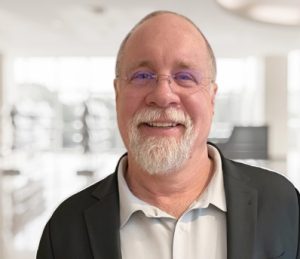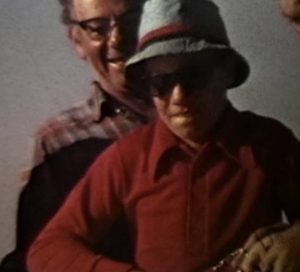As designers, our interface to a foundry occurs via a third party, so many of us don’t get to meet the brains behind silicon processing. Most of us have to settle with detailed PDK documentation or after we have replicated key metrics of the process on Cadence.
Fortunately, I met Jack Pekarik first on a Teams call with other GlobalFoundries’ staff. I was instantly impressed by this softly-spoken, brilliant, yet humble man. So when he suggested we meet in person, in the UK, I jumped at the chance. Finally I got to meet one of my heroes!
Jack Pekarik
But, who is Jack Pekarik?
He is a Fellow at GlobalFoundries and one of the best Silicon Germanium (SiGe) minds in the world. He is known for his work on RFCMOS and SiGe BiCMOS, and has numerous publications and patents in semiconductor research to his name.
Just before Easter 2024, before indulging excessively in delicious chocolate, I met Jack at a garden centre outside Lechlade, in Gloucestershire. Discussing a career in advanced SiGe amidst plants and shrubbery was perhaps not the ideal venue, but it was the most convenient for both of us.
The garden centre had a nice cafeteria, so we sat down to our hot drinks; a coffee for Jack and a builder’s tea for me. Completely at ease, which is a credit to Jack, he told me he and his wife were visiting their daughter, son-in-law and grand-daughter in the UK. He was clearly enjoying his much-earned vacation to the UK, so I asked him what led him to a career in SiGe. I sat back and sipped my tea while Jack recited his tale.
SiGe

A recent picture of Jack, edited using AI by daughter Molly Pekarik Fry to look more high-tech than garden centre. Inspired by Jack’s career choices, Molly works to promote the work of Engineers and semiconductor researchers at Diamond Light Source synchrotron in Harwell, UK.
The first part of Jack’s journey began when he was thirteen. Jack accompanied his father and his father’s friend on a fishing trip. The young Jack plucked up the courage to ask the gentleman why he chose a career in Engineering. He replied because of his love for solving problems and if Jack wished to pursue a career in Engineering, he would have to be good at Mathematics.
Jack recalls;
“I remember thinking this was a good thing – I loved Mathematics, it was my best subject at school”. Judging by the lovely photo below, courtesy of the Pekarik family, the fishing trip was successful. Though I imagine holding such a big fish would’ve tested Jack’s balancing skills on a boat!
Back at home and energised, Jack started taking electronic gadgets apart, such as an eight-track tape deck and AM radios. Occasionally, he could put them back together again and make them work. A trip to memory lane brought a smile to Jack’s face. As a former hobbyist, I could relate to Jack’s enthusiasm for electronics. There is something inexplicably delightful about seeing how things work, especially when there is no parental consent!
Photo of 13 year old Jack on that fateful fishing trip, struggling to lift the day’s catch
IBM East Fishkill
The second part of Jack’s journey began during his university years. While on his summer holidays, Jack secured an internship at IBM East Fishkill. Jack’s focus on learning, dedication, determination and enthusiasm undoubtedly impressed his managers. Consequently, after graduation, he began his first job at the IBM site.
In those early years, Jack worked on Bipolar transistors, where he met Bob Cook and Bob Yun. Both mentored and encouraged him, which inspired him to study further. After agreeing on a leave of absence with IBM, his position reserved for four years, Jack began his PhD on Aluminium Antinomide / Indium Arsenide Bipolar transistors. I could imagine Jack pouring over journals, making copious notes, then returning to the laboratory to fabricate the devices. Jack was married shortly after his graduation, so his wife indubitably supported him during his postgraduate studies.
After completing his PhD, Mr and Mrs Pekarik were busy packing, preparing to move back to East Fishkill, when the phone rang. His manager asked him to move into DRAM development at Burlington. Now, for most people, such a move might have sprayed cold water over their enthusiasm. Not Jack! He embraced the change and after a short spell on DRAM development, Jack moved into RFCMOS.
ST Crolles
The third part of Jack’s journey began when he met Peter Cotrell. Peter noticed Jack’s propensity for leadership and gave him his first managerial role. Peter encouraged Jack to think strategically and recommended a secondment to ST Crolles, in France, to work on RF CMOS, as IBM and ST were partners.
Jack took the offer home to get family buy-in. At the time, Jack had three daughters and his oldest, Molly, sixteen at the time, was in favour of the move. The family packed again and moved to Crolles, staying there for two and a half years.
Jack recalls:
“The older children went to the American School of Grenoble, while the youngest had to spend her first year in a French school, with a British section. She remains our best French speaker and worst speller having the misfortune of both American and British English language instruction.”
Just before his secondment concluded, the greats Jim Dunn and David Harame offered Jack a role to work on SiGe 9HP at Burlington. SiGe 9HP is a 90nm SiGeC BiCMOS process. Jack once again embraced the challenge. The family moved back to Burlington, Vermont. I am equally impressed with Jack’s family for the change they embraced. First from New York to Grenoble, France, then to Burlington, Vermont, US. Clearly the Pekarik family is a closely knit unit.
I really enjoyed listening to Jack’s recollection of his successful career. Curious to learn more, I asked Jack what excited him about his job. He paused for a few seconds, took a sip from his coffee and then stated he loved his job because of the thrill of solving difficult problems. Each day has its challenges. Sometimes, he wakes up in the middle of the night for his Eureka moment, highlighting his commendable passion for his work. Other times, the answer revealed itself after intense work and research.
GlobalFoundries
I had already formed an opinion on Jack before I met him, but for curiosity’s sake, I wanted to determine his career trajectory, from start to present day. The best way of doing that was to ask those he worked for. Jack’s present manager Ted Letavic and Jim Dunn, his former manager, provided the following insight on his ability and contributions to GlobalFoundries.
First from Ted Letavic, a Corporate Fellow at GlobalFoundries:
“I’ve had the pleasure of working with Jack for over a decade, and during this time, he’s proven to be a significant force in the industry. Jack’s natural curiosity and knack for problem solving has been instrumental in his career, but has been an especially great contribution to GF Labs, as it serves as the R&D engine to drive semiconductor innovation forward. It’s even more exciting to see Jack spread the knowledge he’s gained over the course of his career to advance the next generation of engineers at GlobalFoundries.”
Second from Jim Dunn, Head of Technology development, now retired:
“When one meets Jack Pekarik, it is immediately obvious that he has an extensive breadth and depth of device physics knowledge. However, one thing that separates Jack from the crowd is his ability to take client circuit application requirements and synthesize them into device metrics. If we knew where the ‘highest peak’ was, from a device performance perspective, I always knew we had the engineering talent to climb that peak. Jack’s ability to see device development through the lens of client requirements allowed him to act as a mountain guide, of sorts – a critical role on every successful expedition.”
Fellow
My opinion of Jack was firmly calibrated when in early 2022, Jack was appointed Fellow. Most people would be content with such a hallowed position and would put themselves in neutral gear for the remainder of their career. Not Jack!
“I am at a point in my career where I am both grateful for the inspiration and guidance that I’ve received, and excited by the challenges in the field that are to come,” Jack said.
“Fostering excitement for solving future problems in the next generation of STEM professionals is very motivating. My work has taken me around the world – the possibilities for young Engineers are unbounded!”
Beacons
Finally, our conversation moved on to leisurely subjects. He shared his excitement about a family trip to the Peak District and particularly a brewery he was looking forward to visiting. Now there is a common interest for us both outside work!
I suggested he ought to try Bakewell tarts, which is what Bakewell is famous for. There is huge choice from tarts to pies! Yes Bakewell pies, if you can imagine such a dessert and certainly not served with chips!
Our meeting over, Jack and I parted company and on the way home, I reflected on Jack’s career. It’s wonderful to meet people who have fulfilled their career aspirations. They act as beacons for the next generation, who wish to serve Science and Technology for the betterment of humankind.
Jack Pekarik is a true scholar, a gentleman and a SiGe genius! I felt very honoured to have met him and count him as one of my friends.
I’d like to thank Jack for allowing me to write this blog about him, to his daughter Molly for her edits and suggestions, to the Pekarik family for the fishing expedition photograph, to Ted Letavic and Jimm Dunn for their inputs, to Alana Macleod of the Greenough agency for acting as liaison, Stephanie Gonzalez from GlobalFoundries seeking their formal approval, to Alun Williams for posting my blog at Electronics Weekly and most importantly to you the readers for reading this. Thank you!
Author
A veteran of 37 years in the Analog Integrated Circuit Design industry, Ash Madni continues to contribute to the rapidly changing world of Microelectronics. He has worked for a number of big companies, such as Ferranti, STL, GEC Plessey Semiconductors, Maxim Integrated, Dialog Semiconductors, to name a few. He has also worked in startups, such as Phyworks.
During his tenure at GEC Plessey Semiconductors, Ash raised over 20 patents, including Synthesis Exploiting Algebraic Design, which was used successfully in a number of products. Ash is currently running his consultancy, Madni Technologies (UK) ltd.
For relaxation he enjoys walking and spending time with his wife, daughters and grandchildren. He is also active as a published composer and has started his first Sci-Fi horror novel Transmutation – ‘The Rise of Hemonra’.
See also: Viewpoint: British Integrated Design Companies – My personal experience

